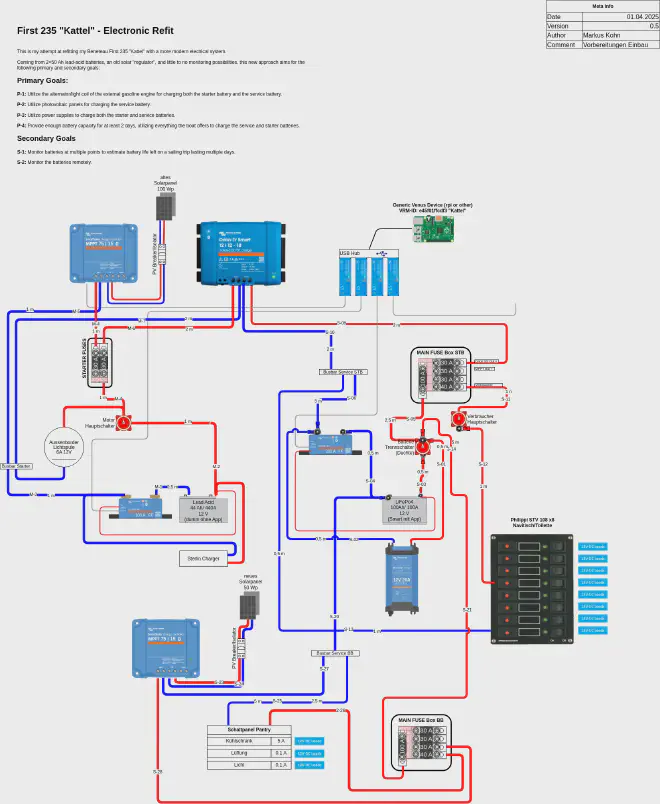If you’re ever planning an electronics refit for your boat, I highly recommend creating a digital plan in advance. Using Draw.IO and resources from the Victron Download & Support area, you can create high-quality schematics.
As a by-product of the planning work, I also built my own cable sizing calculator: https://cables.z1j.de
Feel free to check it out. Whether I’ll further develop the cable calculator is still up in the air.
But now to the final plan – what changed, what remains, and what got tossed?
Before the refit, Kattel had an onboard network consisting of two lead-acid batteries that were used as a battery bank. However, the DC consumers were not powered by both batteries but only by one. In addition, the old solar panel was connected to the batteries via a basic “solar regulator,” and both the navigation and cabin lights were mainly halogen-based.
I also discovered a lot of small inconsistencies on the boat. The cable cross-sections and lengths weren’t always ideal. The connectors between mast and foredeck were also not consistently designed – not a functional problem, but certainly not elegant either.
In earlier articles, I already shared some thoughts on the rough plan – now here is the final version.

This sketch is just a working view – for each version, a wiring and schematic view was derived from it.
Although I tend to stick to semantic versioning, I found that too much overhead for this project. I decided to go with a simple versioning system. Once the conversion work is done, the 0.X versions will be bumped to 1.X to reflect the current state.
During planning, I also wanted to get professional feedback on version 0.3. I reached out to Jadeyachting: https://jadeyachting.de/
Spending money on a review of my plans is a decision I’d make again anytime, and I can recommend it to anyone working on a project of similar complexity.
After a short introduction email, I received an offer and we scheduled a joint review session.
I had prepared lots of questions for the session and sent them to Jade Yachting in advance. Having a solid plan was extremely helpful in formulating targeted questions and suggestions. Once again, planning paid off.
How much time did I spend on the documents? I’d roughly estimate around 16–24 hours spread over four weekends.
There’s also been some progress on integrating live position tracking. A Raspberry Pi is running Victron’s Venus OS, which will later help me monitor the boat’s energy systems in real time. At the same time, it can send GPS data, via a USB GPS receiver, to both the VRM platform and my own servers. A test integration with my Grafana and InfluxDB setup has already been completed. I’m still figuring out how to display this data live on the blog, but I’m already working on a potential solution.
Next, I’d like to share a few more updates on the ongoing work aboard. I’ve already managed to remove quite a bit of old wiring from the boat, along with some outdated electronics. Now that the weather is starting to warm up, I have to actively stop myself from diving into two new projects: ceiling and wall paneling, and installing a new onboard toilet. Both of these will likely have to wait until the next winter haul-out.












